
‘Lake Tahoe has a people problem’: how a resort town became unlivable | California
Late last year, Lake Tahoe earned a spot on an exclusive travel guide. But the mountain destination, famed for its cobalt blue waters and Olympic-quality ski resorts, wasn’t there for the reason you’d think.
Fodor’s “No list” highlighted beloved getaways that needed a break, and Tahoe was up there with the neediest. Citing a pandemic influx of remote workers, second home buyers, traffic gridlock and packed beaches, the guide concluded “Lake Tahoe has a people problem”.
While not everyone agreed with the guide’s blunt recommendation, the superlative spoke to a reality that’s become impossible to ignore: Tahoe had changed significantly in the pandemic years and many locals say not for the better.
Signs of the region’s popularity are evident all around its tree-lined shores in the form of endlessly booked short-term vacation rentals and for sale signs that popped up outside modest family cabins and multimillion-dollar chalets alike. As Covid surged, new residents had flocked to the towns and cities along the lake, sending real estate prices soaring to staggering highs. Prices doubled and even tripled in some areas – median home prices in the basin climbed from $345,000 in 2012 to $950,000 in 2021, according to a report from the Tahoe Prosperity Center.

Homeowners cashed in on the demand. Rents rose and the housing shortage grew more severe, pushing locals east to more affordable cities such as Reno and Carson City. In turn, local businesses struggled with a depleted workforce. Ski resorts looked to campgrounds and tiny homes to house workers while short-staffed restaurants reduced their opening hours.
“It’s been getting progressively worse,” Clay Kuecker, a lifelong resident, said while sitting at the bar of a restaurant on the lake’s north shore. “The market is so tight and the demand is so high [sellers] get whatever they want. Renters cross [their] fingers and hope the owners don’t sell.”
The story of Lake Tahoe is a microcosm of what’s happening in communities across California and the US, where longstanding housing problems have been intensified by the pandemic. The resulting upheaval has fueled fear and uncertainty about Lake Tahoe’s future, and forced the area to confront a difficult question: who is Tahoe for?
“It’s hard to stay here,” said Heidi Hill Drum with the non-profit Tahoe Prosperity Center. “The only way to get our community back is to build housing for people who are the backbone of our economy: the tourism workers. We’re not helping them right now – not enough.”
Constant stream of tourists
Every year about 15 million people travel to Tahoe to enjoy the lake or snowboard and ski at the area’s world-class resorts – a larger number of visitors than Disneyland, Yosemite national park or Napa Valley wine country. On a recent December day, the snow-covered streets were filled with large groups of tourists on their way to the shores of the lake or pizza joints and Mexican restaurants after hitting the slopes.
Tahoe also serves as a playground for the rich and famous – Kim Kardashian, Justin Bieber and members of the Real Housewives are among its most famous visitors. The constant stream of tourists keeps communities around the basin, which straddles five counties across California and Nevada, bustling year-round.
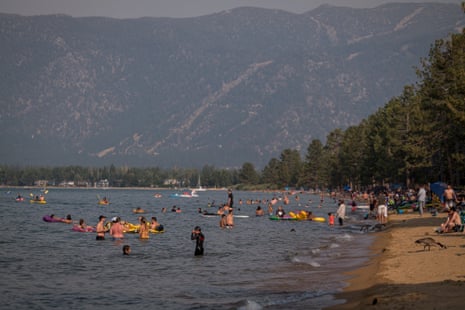
The millions of visitors are sustained by a population of just 56,000 residents who keep the community running by working in law enforcement, fire departments and at local hospitals, staffing restaurants and ski resorts and teaching students. Those who have settled here permanently were usually drawn to the area’s natural beauty and outdoor lifestyle. Countless residents share stories of coming for seasonal jobs and deciding to stay, despite the intense winters, limited job opportunities and housing challenges.
People have continued to settle here even as environmental pressures have mounted, including fast-moving wildfires that have threatened entire towns and severe winter storms that have knocked out power and cut the area off from the outside world for days on end.
“The winters can be rough. We joke we have some of the most overeducated bartenders and servers in the nation. It’s a choice you make to live up here, to just make it work,” said Alicia Barr, the co-founder of FiftyFifty Brewing in Truckee.
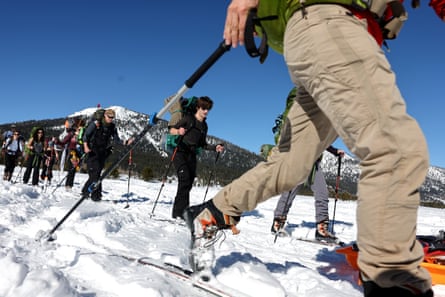
But, by design, growth in Tahoe has been relatively slow, and the region’s housing challenges started before the Zoom town boom or the rise of short-term rentals. There is a limit to how much housing can ever be constructed in the basin, as well as height and coverage regulations to preserve the natural landscape. Those factors make it challenging to complete projects in the region, said Meea Kang, an affordable housing developer who has worked in Tahoe – a perspective shared by other developers.
“We have extremely high land costs, compound that with some of the highest construction costs in the whole country and you have limited actual locations for those projects. It makes it extremely difficult,” said Daniel Fraiman, a developer in Tahoe.
In the mid-20th century, when the area served as a getaway for stars such as Frank Sinatra and Marilyn Monroe, planners envisioned a city the size of San Francisco on the shores of the lake with freeways around the basin and bridges across the bay. At the time the area was growing rapidly, and haphazardly, with developers filling in wetlands and the clarity of the famously clear lake quickly declining, said Jeff Cowen with the Tahoe Regional Planning Agency. The planning agency was established in 1969 to regulate development in the basin and protect the environment of the lake.
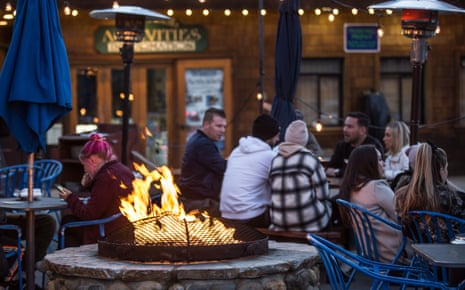
Still, Tahoe managed to grow, its population reaching a record 60,000 in 2000. At that point, unlike some other famed resort communities, homes in the area hadn’t yet surged to unaffordable levels.
“When I moved here in the early years, you could find a house pretty easily. You could go on to Craigslist and ask around and rent a place,” said Fraiman, who is also a planning commissioner in Truckee. “You used to be able to find a room in a house that somebody who was making a regular wage could afford,” he said. “The property values have not come back down and I don’t know if they ever will.”
The area’s population was on the decline for 20 years, particularly after the great recession in 2008, but the area’s housing challenges began to pile up amid strict housing regulations and vocal opposition to affordable housing projects. Between 2012 and 2021, the region expanded its housing inventory by only 1{6d6906d986cb38e604952ede6d65f3d49470e23f1a526661621333fa74363c48}, most of which were large, expensive homes for second-home owners.
Drum and others point to both the opposition to affordable housing efforts and strict rules around development to explain the shortage. Tahoe has struggled to balance its efforts to preserve the environment and support those who live there.
“We don’t have a good track record of doing both. We talk about the triple bottom line: economy, the community and the environment. But we don’t have a good track record of balancing that,” Drum said.
“We haven’t built enough homes for our workers, for our local residents. We haven’t kept pace for what our community needs,” she said.
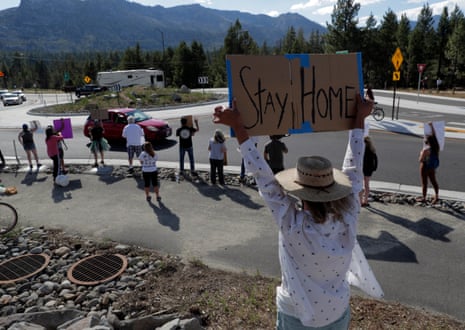
More than 3,000 people moved to the basin in 2020 at the height of the pandemic – the largest one-year population increase on record – and the need for housing was greater than anyone had prepared for. Longtime residents found themselves with nowhere to go when their landlords announced they would sell their properties.
For businesses such as Las Panchitas, a Mexican restaurant in Kings Beach, the crisis has manifested as a scramble for staff. The 40-year-old eatery, housed in a wood building with a rock facade on the lake’s north shore, has been short-handed for two and a half years, the owner Alex Brambila said.
Las Panchitas is an institution where Brambila greets most customers by name: “Everybody’s famous in Kings Beach,” he jokes. “We all know each other.” Most of the restaurant’s staff has been there for years, Brambila said, but the high cost of housing has made it increasingly difficult to find workers. Standing behind the bar while preparing a margarita, Brambila says his business is now open six days a week, one day less than they were two years ago, and he works additional hours so that employees can have some time off. “There’s no lodging and housing went up almost double. My guys … they have to work like crazy to pay rent.”
Seated at the tile-covered bar, Clay Kuecker, who was born and raised in the area, commiserated with Brambila about the changes. As costs have risen, friends and family members have gotten priced out of the region, he said, migrating to more affordable areas and then spending hundreds of dollars a month to commute back to Tahoe for work. “My brother got forced out of Tahoe. He’s had to move a lot,” he said. “It really sucks. It’s just tough.”
The region needs tourism to survive – something Kueker, who builds custom homes, knows personally. “We’re a resort town – we rely on that money. All my clients are from out of town,” he said. But without more affordable housing, “[Tahoe] will only be for the wealthy.”
Change … but not overnight
Twenty minutes from the lake’s north shore lies a vision of what a more sustainable Tahoe could look like.
It’s a collection of 40 new three-bedroom homes with crisp white paint and large windows that frame a snowy field dotted with firs, and a starting price of $577,500. Daniel Fraiman, the housing developer, hopes this neighborhood, where homes can only be sold to and occupied by local workers who make no more than 180{6d6906d986cb38e604952ede6d65f3d49470e23f1a526661621333fa74363c48} of the area median income, can help alleviate the area’s housing shortage.
“What we’ve attempted to create here is a little bit of a community,” he said while pointing out how the duplexes in Hopkins Village provide room for families and have garages with room to store skis and snowboards.
The project is designed to serve locals who couldn’t otherwise afford a home in the area, but make too much to qualify for affordable housing.
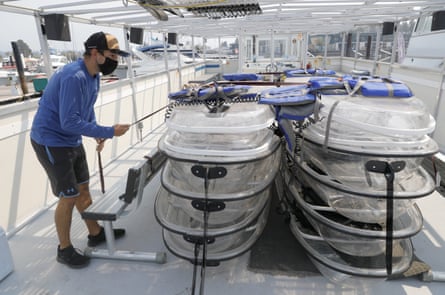
Developments like Hopkins Village play an important role in chipping away at the housing crisis, Fraiman said, as the area continues to grapple with the changes that came with the pandemic.
Officials warn turning the tide will take time, and a multi-pronged approach – they have put forward solutions that include down payment assistance, deed-restricted housing, restrictions on short-term rentals, and cash incentives for second-home owners who rent to locals. Sugar Pine Village, which Kang developed, will bring 248 units of affordable housing to South Lake Tahoe, the largest single development approved by the Tahoe Regional Planning Agency.
More housing developments like these are needed, a process that – due to high costs, tight regulations and limited available building space – will take years.
“This is not an overnight change. This has been happening for, say, 20 years. It may take us 10-20 years to really make significant strides in this,” said Cindy Gustafson, a Placer county supervisor who works closely on housing issues. All of her sons had to leave the area to afford homes, and the continued exodus out of the area hurts the fabric of the community, she said.
Without meaningful change, quickly, Drum fears Tahoe will lose that social fabric, and there won’t be much left for those who live here, or for tourists.
“There won’t be a restaurant like Las Panchitas where you walk in, you know people. Snow removal will take a lot longer. It’ll be hard to find somebody to babysit your kids when you want to have date night,” she said. “ I don’t think it’ll be as fun of a place to visit. There won’t be a community.”
